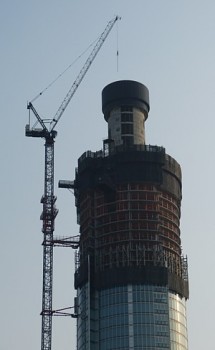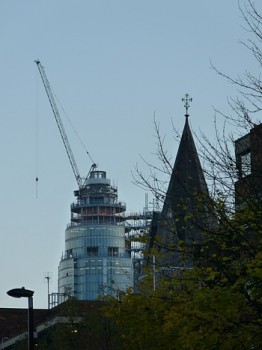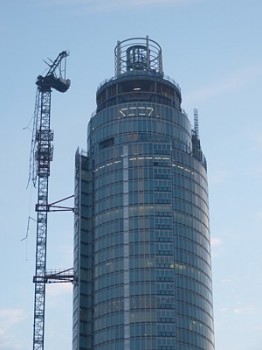I like photographing new London buildings, the taller the better. And I am also very fond of photographing cranes, which can be quite dramatic but will soon be gone. So, when a new tower started getting built just across the Thames from me, all the while lovingly tended by just the one very tall crane, I photoed it, quite often.
Here is how the tower and its crane looked in May of last year.
That’s a shot taken from Vauxhall Bridge.
Here is a somewhat more artistic shot of the top of the tower, and its crane, taken last November, from Vauxhall Bridge Road, which is to say from rather further away:
But now look at them, as photoed by me this afternoon:
The tower is okay, but the crane is in a sorry state.
During this morning’s rush hour, when it was very misty, a helicopter smashed into the crane. As you can see, the crane suffered badly, but what happened to the helicopter was far worse. It lost its blades, plummeted to the ground in flames, killing its lone occupant, the pilot, and another person on the ground. Blazing aircraft fuel was all over the place, and nearby cars were engulfed in the resulting flames and themselves also exploded. Had it happened rather later, when the road where all this happened would probably have been traffic-jammed, it might have been an order of magnitude more horrific.
Not surprisingly, this is one hell of a news story.
This afternoon I got nowhere near where all this drama had happened, and didn’t seriously try to. But a zoom lens was all I needed to photo what happened to the crane, and this will surely get photoed a lot, for as long as it stays up there for all the world within about half a mile to see. I’m guessing that there is going to be lots of tidying up and sorting out to be done at ground level, before it will become possible to replace the crane, and finish building the tower.
Terrible. Deadly. And, given how costly it is when a major building project is at all seriously delayed, as this one surely will now be: very expensive.
LATER: A better view of the ruined crane, in the form of an expanded detail of the crane itself, minus most of the tower, here.







Brian, I doubt there will be any tidying up at ground level until they sort out that crane. Cranes of that sort have massive counter weights to keep them balanced. Think of the lever arm of the crane and you’ll understand the weights. Getting those weights safely removed from the crane is a job I can’t imagine. They are too heavy for a helicopter, I expect. Even if so, somebody(s) has to go out on an extremely unstable turret to both detach the weights from the turret and attach them to the helicopter or alternate crane.
I doubt they can use that same tower for removing the weight since it is now extremely eccentrically loaded and is probably itself damaged. Perhaps they will find a way to mount a jib boom to the building safely enough to lower the weights one at a time and then the boom, turret and tower. I doubt they’ll be able to continue to use it but they may be able to give it an adequate inspection in situ once the weights, dangling boom and turret are removed.
Please do keep us informed and take pictures.
And I hope you have a long lens. If not, it might be a good excuse to buy one.
Brian, I am so sorry, for all concerned. Let me join Mid: please keep us posted.
One little niggle: I like your first shot best! Just the two verticals, with the crane leading the way into the lonely sky….
(Although I gots to admit, the tower isn’t at its best just yet. *g*)
I am may be proven wrong eventually, but the tower looks hideous.
The poor gui in the helicopter had no chance. Loosing a blade or a part of a blade makes flying or autorotation impossible. The helicopter will inevitably crash.
A terrible event.
As an erstwhile pilot I wonder; did you ever note -was there a blinker light on the mast head?
It was a terrible accident but could have been much worse in terms of loss of life.
As for getting the crane dismantled I’m wondering if it would be feasible to erect an identical crane next tot he damaged one and use its lifting capacity to dismantle the damaged one.
Brother J,
They may need to but I wonder if the crane to building attachment points are built into the structure. That would make a second crane very expensive.
Another thought occurs to me. First, the good news, there appear to be only a quarter to a third of the counterweights being used in this installation. That is probably why the turret didn’t snap off. But. Those counterweights appear from Brian’s picture to be dangling over the crane to building attachments. If the weights were to fall, they could take them out and allow the tower to tip, falling tree style. That greatly enlarges the hazard zone.
I really hope I’m wrong about all this and that it is a simple recovery. I know nothing of cranes except watching them.
Midwesterner:
If the cranes there are built like cranes here in Canada, the counterweights are made of separate plates small enough that a large helicopter could lift them individually. But it would be a tricky operation and there would probably be some public resistance to such a plan, under the circumstances! A second crane or other supplementary structure would be slower, but safer and probably more popular. If nothing else, it would please the lawyers more.
JP — Um, yes. So far as it’s finished, it somewhat reminiscent of a grain silo. (They look fine attached to barns though, and this thing wouldn’t.) But then, for the last quarter-century, over here there’s been a vogue for building churches that resemble nothing so much as those complete grain-elevator buildings you see, or used to, right next to the railroad in farm country.
Of course, the really big new churches tend to look like warehouses.
However, in the circular-tower vein, you might care to check out Chicago’s famous Corncobs (a.k.a. Marina City), at
https://en.wikipedia.org/wiki/Marina_City
I assure you, they are not particularly beautiful in the concrete, so to speak. Then there is the Cloverleaf, not a tower, but an out-and-out excrescence. Apparently the owner, Northwestern U., would like to dispense with it. Historical-landmark types (with no taste whatsoever, IMO) are resisting loudly. You might wish to fortify yourself with a shot, before looking:
http://www.metropolismag.com/pov/20101116/celebrating-the-corncobs-saving-the-clover-leaf
These things are very difficult to deal with. Also very deadly. Regarding you interest in cranes you are most likely familiar with the crane drama NYC went through a while back with Sandy.
If not, here is a link to an article about securing the damaged crane:
http://www.nydailynews.com/new-york/dangling-crane-57th-st-secured-6-days-snapping-sandy-article-1.1196876
And here’s another article about the construction delays:
http://www.bloomberg.com/news/2012-12-12/one57-crane-mishap-to-delay-completion-of-manhattan-tower.html
According to The Telegraph “One witness said the 15-year-old Agusta A109 appeared to be “spinning out of control” seconds before it hit the crane’s jib, which had red warning lights on it and was on a list of hazards circulated to pilots.”
That suggests the possibility that there was a problem with the tail rotor which is what keeps the fuselage rotating about the main rotor shaft in the opposite direction to the main rotor. He would have had no directional control. That’s a terrifying thought.
Speculation may be fun, but I would regard any publicly available information about the accident with a high degree of skepticism at this stage, especially eyewitness accounts. While they occasionally provide useful information, especially if the eyewitness is a pilot or other knowledgeable person, in general the signal to noise ratio of eyewitness accounts of aviation accidents is terrible.
I thought it was very interesting that CNN International was running the story hours ahead of the BBC, at least online. Any significance to that?